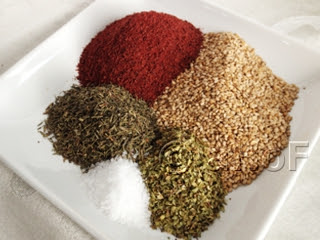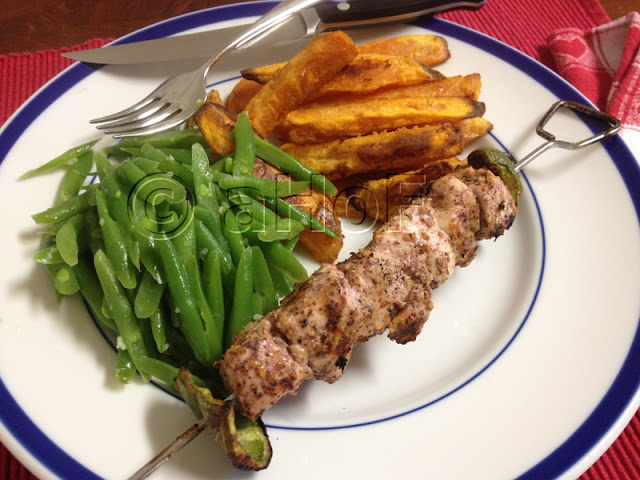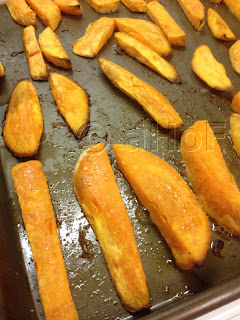 |
| Clockwise from top: sumac, sesame, oregano, salt, thyme |
What is Sumac, and is it related to Poison Sumac?
You might hear the word Sumac and immediately think, "Poison Sumac?" The Mediterranean spice, sumac is not from the same plant as poison sumac, though it is in the same family. The sumac used in Zah'tar and other Mediterranean and Middle Eastern cuisines grows wild only in those areas, so there is no chance of running afoul of the wrong plant. The poison sumac here in the US is from a plant called Rhus vernix, where the Mediterranean plant sumac is from the plant Rhus coriaria.Zah'tar
Makes about ¾ cup
¼ cup sumac powder
¼ cup raw, unhulled sesame seeds (may be toasted in a dry pan first)
2 tablespoons dried oregano leaves (not powder)
1 tablespoon dried thyme leaves (not powder)
1 teaspoon salt
If toasting sesame seeds, place them in a dry frying pan and stir constantly until they begin to pop and snap. Remove from heat immediately and pour onto a plate to cool. Grind all ingredients together in a mortar and pestle, or briefly pulse together in a spice grinder.
Store Zahtar in a clean glass jar with close fitting lid for up to 3 months.
 |
| Lemon Zah'tar Chicken served with Sweet Potato Oven Fries and Green Beans |
 |
| Lemon Zah'tar Chicken on the grill |
Lemon Zah'tar Chicken
Serves 3 or 4
 |
| Kebabs, before and after grilling |
3 to 4 boneless, skinless chicken breasts
MARINADE:
2 tablespoons olive oil
2 tablespoons Zah'tar
1 teaspoon fresh lemon zest
2 tablespoons fresh lemon juice
½ cup unflavored Greek yogurt
2 cloves garlic, minced
1 teaspoon salt
few grinds fresh black pepper
Cut the chicken breasts into about 1 1/2 or 2-inch cubes. Place the cubes of chicken into a zip-top bag or other container with a lid. In a bowl, mix together all the marinade ingredients until well combined, then pour over the chicken cubes and mix well to coat all sides of the meat. Let the chicken marinate for at least 1/2 hour in this mixture, or up to 2 hours, maximum. After this time the chicken starts to break down from the yogurt and becomes slightly mushy.
Slide the cubes of chicken onto shish kebab skewers, anchoring the meat at the ends with slices of carrot or bell pepper.
Light a grill and once hot, either lower the temperature to medium low, or push most of the coals to one side. Grill over lower heat for about 4 minutes per side, or until the internal temperature is at least 160 to 165 degrees.
While thinking about the recipe for the chicken, I was also thinking of what to serve with the kebabs. I bought a couple of sweet potatoes and made oven fries, similar to my regular Oven Steak Fries. Sweet potatoes, despite being somewhat harder to cut through than regular white potatoes, bake faster than white potatoes. When making oven fries, I like to mix melted butter and olive oil together for the great flavor. The butter could be omitted and all oil substituted. For the Sweet Potato Oven Fries I also added some seasonings, as well as first tossing the raw potato in a little cornstarch. This step was a bit of an experiment. I was hoping for a slightly crisper outside texture. My sweet potato slices were not of even thickness, so some got brown and others did not, but all were well cooked. Just not crisped. I will add the cornstarch to the recipe here; whether to use it is up to you.
 |
| Sweet Potato Oven Fries |
Sweet Potato Oven Fries
Serves 2 to 4
2 pounds sweet potatoes
1 teaspoon cornstarch
1 tablespoon olive oil
2 tablespoons melted unsalted butter
1 teaspoon salt
¼ to ½ teaspoon garlic powder
Preheat oven to 400 degrees (375 on Convection Bake). Peel the sweet potatoes and cut them into thick lengths, as for "steak fries". Sprinkle the cornstarch over the potato pieces and toss well to coat. Place the sweet potatoes in a zip-top bag or other container with lid and pour on the oil and butter, then add in the salt and garlic powder. Seal the container and toss well to coat completely. The potatoes can be held at this point for up to an hour before baking.
Pour the potatoes onto a rimmed baking sheet large enough to hold all the pieces with space between. Bake them for about 10 to 12 minutes. Remove from oven and turn all the pieces over. Return to the oven for another 10 to 12 minutes, or until they are golden and cooked through. Serve immediately.
My passion is teaching people how to create a harmony of flavors with their cooking, and passing along my love and joy of food, both simple or exotic, plain or fancy. I continue my journey in ethnic and domestic cuisines, continuing my journey to explore diverse culinary experiences and hopefully to start you on a journey of your own. Join me also at A Harmony of Flavors on Facebook, and Pinterest.

No comments:
Post a Comment